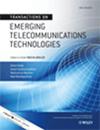{"title":"无线传感器网络绕行模式的能量感知多路径地理路由","authors":"Haojun Huang, Guangmin Hu, Fucai Yu","doi":"10.1002/ett.1490","DOIUrl":null,"url":null,"abstract":"For energy-constrained wireless sensor networks, we present an Energy-aware Multipath Geographic Routing (EMGR) protocol. EMGR utilizes geographic information, the characteristics of energy consumption and the metric of advanced energy cost to select the next forwarding node, and uses a dynamic anchor list to shift routing path for load balance. Simulation results show that EMGR is superior to other protocols in terms of energy efficiency, network lifetime, end-to-end delay, and packet delivery ratio. Copyright © 2011 John Wiley & Sons, Ltd.","PeriodicalId":50473,"journal":{"name":"European Transactions on Telecommunications","volume":"50 1","pages":"375-387"},"PeriodicalIF":0.0000,"publicationDate":"2011-11-01","publicationTypes":"Journal Article","fieldsOfStudy":null,"isOpenAccess":false,"openAccessPdf":"","citationCount":"20","resultStr":"{\"title\":\"Energy-aware multipath geographic routing for detouring mode in wireless sensor networks\",\"authors\":\"Haojun Huang, Guangmin Hu, Fucai Yu\",\"doi\":\"10.1002/ett.1490\",\"DOIUrl\":null,\"url\":null,\"abstract\":\"For energy-constrained wireless sensor networks, we present an Energy-aware Multipath Geographic Routing (EMGR) protocol. EMGR utilizes geographic information, the characteristics of energy consumption and the metric of advanced energy cost to select the next forwarding node, and uses a dynamic anchor list to shift routing path for load balance. Simulation results show that EMGR is superior to other protocols in terms of energy efficiency, network lifetime, end-to-end delay, and packet delivery ratio. Copyright © 2011 John Wiley & Sons, Ltd.\",\"PeriodicalId\":50473,\"journal\":{\"name\":\"European Transactions on Telecommunications\",\"volume\":\"50 1\",\"pages\":\"375-387\"},\"PeriodicalIF\":0.0000,\"publicationDate\":\"2011-11-01\",\"publicationTypes\":\"Journal Article\",\"fieldsOfStudy\":null,\"isOpenAccess\":false,\"openAccessPdf\":\"\",\"citationCount\":\"20\",\"resultStr\":null,\"platform\":\"Semanticscholar\",\"paperid\":null,\"PeriodicalName\":\"European Transactions on Telecommunications\",\"FirstCategoryId\":\"1085\",\"ListUrlMain\":\"https://doi.org/10.1002/ett.1490\",\"RegionNum\":0,\"RegionCategory\":null,\"ArticlePicture\":[],\"TitleCN\":null,\"AbstractTextCN\":null,\"PMCID\":null,\"EPubDate\":\"\",\"PubModel\":\"\",\"JCR\":\"\",\"JCRName\":\"\",\"Score\":null,\"Total\":0}","platform":"Semanticscholar","paperid":null,"PeriodicalName":"European Transactions on Telecommunications","FirstCategoryId":"1085","ListUrlMain":"https://doi.org/10.1002/ett.1490","RegionNum":0,"RegionCategory":null,"ArticlePicture":[],"TitleCN":null,"AbstractTextCN":null,"PMCID":null,"EPubDate":"","PubModel":"","JCR":"","JCRName":"","Score":null,"Total":0}
引用次数: 20
Energy-aware multipath geographic routing for detouring mode in wireless sensor networks
For energy-constrained wireless sensor networks, we present an Energy-aware Multipath Geographic Routing (EMGR) protocol. EMGR utilizes geographic information, the characteristics of energy consumption and the metric of advanced energy cost to select the next forwarding node, and uses a dynamic anchor list to shift routing path for load balance. Simulation results show that EMGR is superior to other protocols in terms of energy efficiency, network lifetime, end-to-end delay, and packet delivery ratio. Copyright © 2011 John Wiley & Sons, Ltd.

 求助内容:
求助内容: 应助结果提醒方式:
应助结果提醒方式:


